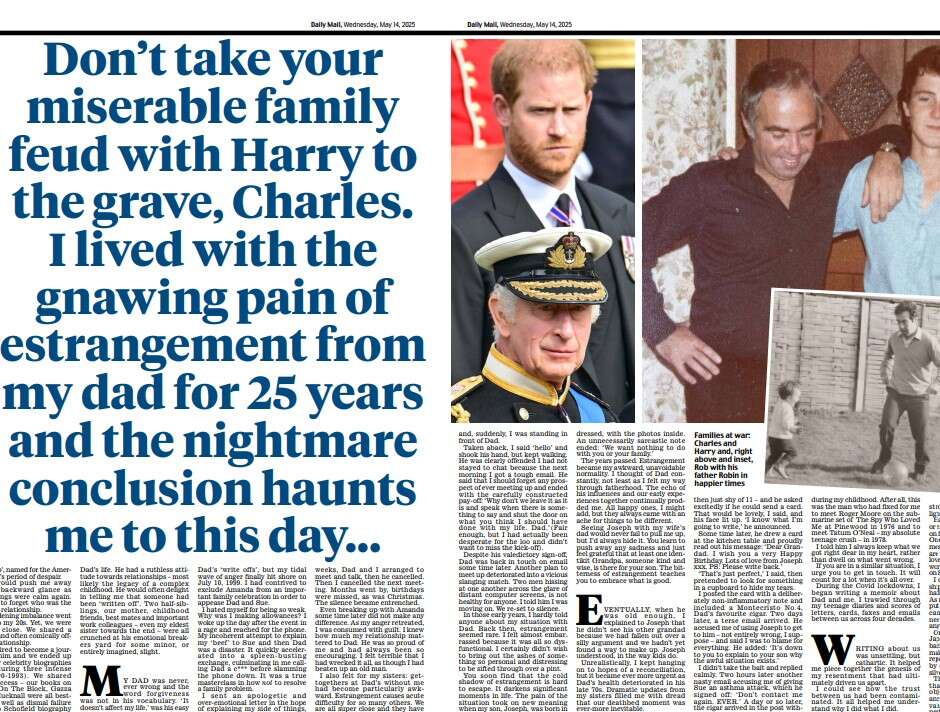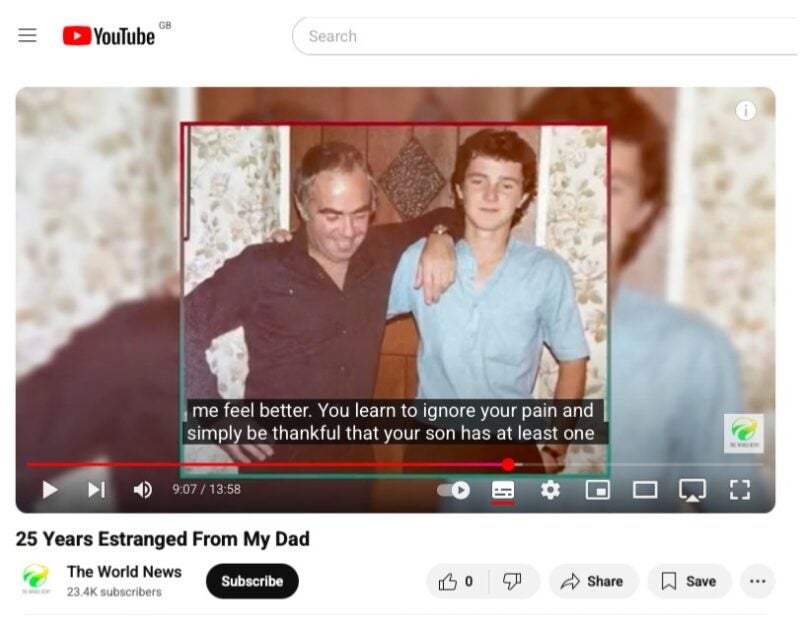
Youtube channels are using AI to steal words and photographs from paywalled news content and reproduce articles wholesale without the consent of publishers.
The practice has been highlighted by freelance journalist Rob McGibbon after a first-person account of his estrangement from his late father written for the Daily Mail was lifted wholesale and reproduced by the Youtube Channel: “The World News.” Youtube is part of Google, which made at least £20bn in UK advertising revenue last year.
He said: “Google are handling stolen goods in plain sight and governments must find the way to hold them responsible. In the real world selling on stolen stuff is as serious as the criminal who stole it in the first place. Why should it be different in the virtual world?”
Youtube does not pro-actively remove videos which breach copyright in text and images. McGibbon said he has no faith in Youtube’s copyright complaints process, which in any case takes at least seven days to play out. And he said it should not be on creators to track down the multiple breaches of their copyright which occur on Youtube but for the tech platform to ask permission in order to use copyright work.
This mirrors the current debate during the Data Bill currently going through Parliament. The UK Government contends that AI companies should have the right to take copyright work unless creators explicitly opt out.
Youtube does use software to proactively take down music which is used in breach of its copyright rules (music videos are a lucrative form of revenue for Youtube).
McGibbon has complained over two articles which have been stolen and used on Youtube: the Daily Mail account of his difficult relationship with his father (published on 14 May) and an interview with actress with Felicity Kendal in The Times (published on 13 July 2024). Both sit behind online paywalls.
McGibbon, who is also editor of The Chelsea Citizen, said of the Mail article: “It was such a deeply personal piece – and by far the hardest story I have ever had to write – that I was determined to control the copyright. I didn’t want it being ripped off by anyone.”
But within a few hours a YouTube channel, “The World News” had taken McGibbon’s copy and turned it into a 14-minute video, with the entire content, approximately 2,000 words, read out by an AI narrator. Childhood photographs supplied by McGibbon to the Daily Mail for one-off use only were also added in as a video montage without permission.
McGibbon said he was “absolutely disgusted” to see an AI audio version of his story published on YouTube channels.
Inaccuracies were introduced by the AI narrator who described McGibbon’s feud with his father as “violent”. He said this was absurd because he had not seen his father for 25 years.

McGibbon said the use of AI to create scripts from his stories shows how the technology “completely rips off [his journalism] and distorts it all to make advertising revenue for some invisible operator”.
The channel has since been taken down by Youtube because of what it called “spam” violations, rather than copyright infringement. But it had previously posted 16,000 videos in 13 years and received 15 million views.
The Times article has also been also ripped off by several YouTube channels with an AI narrator. McGibbon said he complained to YouTube about the interview being published without correct accreditation, but received no acknowledgement or reply.
The channel continues to stay online and run adverts around McGibbon’s work.
McGibbon said: “I think every single journalist should wake up and fight for their copyright, particularly freelances. You don’t want your copy ripped off, rehashed, because it will carry on. Your work will feed all these websites forever.”
Annalisa Checchi, partner at Ionic Legal law firm, which specialises in intellectual property and technology law, said publishers were “already on the back foot” because of a lack of a meaningful update to copyright law for nearly 40 years.
She said: “The last meaningful update to UK copyright law was in 1988, over three decades ago. Now, in 2025, AI is becoming mainstream, reshaping how content is created, shared, and monetised. The law should have been modernised long before this. We’re seeing too little, too late, leaving creators and publishers struggling to protect their work in the digital age.”
AI theft of paywalled content
Checchi noted that this was the first time she had seen a case where AI appeared to copy content from behind a paywall.
“I’d be really interested to understand how the tech pulled this off. Could AI be generating dummy accounts or logins to access paywalled content, or using some sort of ‘bunny hopping’ method to bypass restrictions? It’s likely the technology behind paywalls just isn’t sophisticated enough to catch this kind of thing. With so many workarounds emerging, we’re looking at a systemic challenge.”
She explained that AI systems don’t necessarily “hack” paywalls in a traditional sense, but instead exploit common weaknesses. These include creating multiple fake accounts to use limited free access, using browser automation tools to mimic human behaviour, or abusing APIs designed for legitimate user access. In some cases, AI-powered scrapers can chain together snippets from various sources – including cached pages, RSS feeds and previews – to recreate full articles.
“The worrying thing is how scalable these methods are becoming with AI,” Checchi said. “This isn’t just a one-off. This is a systemic issue publishers and creators face as technology continues to evolve faster than the laws protecting them.”
Henry Smith-Higgins, a lawyer at Waterfront Law, said the lack of transparency makes it “unclear” who a creator can sue over copyright infringement.
Smith-Higgins pointed to the ‘black box challenge’ – one of 12 AI challenges identified by the UK government, where an AI’s deep learning system and how they make their decisions are a mystery to its users.
He said: “This is one of the biggest challenges, because when you’ve got AI being used, there are difficult questions around copyright, and in particular, as to authorship, ownership and infringement.
“So is copyright owned by the AI bot itself? We’ve seen cases to do with patents, where the courts have ruled that AI cannot be the inventor of a patent. Likewise, for copyright, the author must be a ‘person’, which is interpreted as being a human or company. In relation to computer generated copyright work, the author is the person who makes the arrangements necessary for creating it, and the first owner is generally the author.
“In which case, is it the company who created the AI? Or is the owner the individual who puts in the prompt or otherwise instructs the AI to scrape data to create the output? That’s a difficult question, and even if established, it can be difficult for creators to prove that their work had been copied due to the lack of transparency surrounding the use of AI.”
Youtube says it provides tools to make copyright claims
A spokesperson for Youtube told Press Gazette that YouTube “doesn’t mediate copyright claims”, and that it is an issue between the parties involved.
They said: “This means it’s not up to Youtube to decide who ‘owns the rights’ to content, which is why as an intermediary, YouTube gives copyright holders tools to make copyright claims and uploaders tools to dispute claims that are made incorrectly. This process complies with the law.
“If someone believes that their copyrighted content is being used without authorisation, they can submit a copyright takedown notice through our webform. When a copyright holder notifies us of a video that infringes on their copyright, we remove the content promptly in accordance with the law, and terminate the accounts of repeat offenders.
“A copyright strike can be resolved if the user submits a counter-notification and prevails in that process.”
Email pged@pressgazette.co.uk to point out mistakes, provide story tips or send in a letter for publication on our "Letters Page" blog
